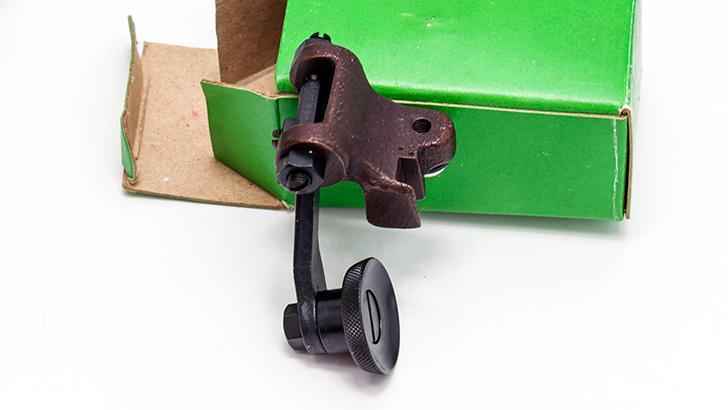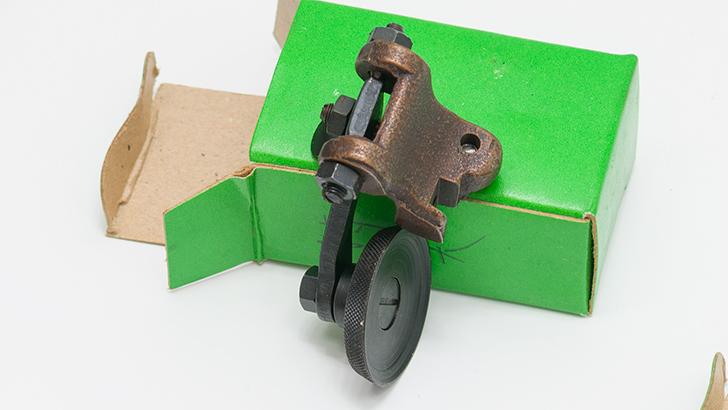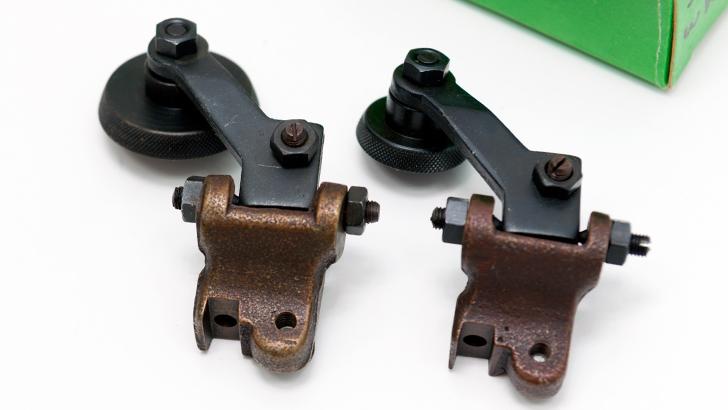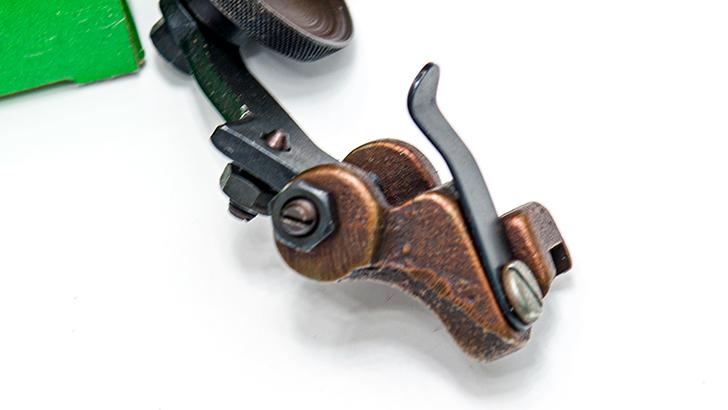
kgg
Contributing Member-
Posts
3,299 -
Joined
-
Last visited
Content Type
Profiles
Forums
Events
Blogs
Gallery
Everything posted by kgg
-
Thank you. The trick was to making the back section flexible enough to bend slightly too allow the awl into the sheath. Thank you, I never thought of that use. I might have a chance later to night to make one with a shorter needle, more pen like.
-
I have always had a problems with round handled tools in general wondering away and the awl was no different. So I built my own scratch awl and dolled it up with some 3d printed features to act more like a pen with a comfort indent for my index finger and end cover for the wooden handle. That seemed to take care of the awl but not the wondering when laid down. So I 3d printed a flat bottom sheath with the inside shaped to fit the contours of the awl and a handle stop so it does fall out. Also it protects the needle and me from getting poked. The next problem was to make the whole package do more. As I do a fair bit of inside out sewing that then requires it be turn right side out, much like you would do for a pillow case, getting the corner bunching out has been a problem. So the nose had to be nice and round but blunt so it wouldn't punch through. Also when I use double side tape to hold items together I have used various item to press the pieces together so I needed a little contour at the bottom side of the nose to held flatten pieces together. I used cheap and I mean cheap PLA for this prototype and didn't dial in the printer to handle this PLA which is less forgiving on the heat and horizontal expansion compensation settings. This is what I came up with. Any comments or improvement suggestions are always appreciated. PHOTO: 1) awl with index finger comfort indent 2) sheath round nose with bottom contour for flattening 3) awl and sheath with hangup string 4) how the awl fits my hand much like a pen would 5) awl in sheath with a index finger comfort indent 6) how awl and sheath fits my hand much like a pen would for flattening kgg
-
How far away are they, it maybe worth a trip and do you have a dealer repair shop within the same distance range that may have a similar machine? kgg
-
Does it have a servo motor if not add at least $150 to the price you are paying. Without photo's that shows the overall condition and detailed ones of the thread path and bed, getting an answer is going to be difficult. If the machine is in mint condition no missing parts, no thread worn gouges in the thread path tensioner's, no path worn off the bed, servo motor and most importantly sews properly then I would. kgg
-
I do own a Juki 1541S and they are a good machine. They are rated for V138 top and in the bobbin but probably could take V207 at least as a top thread. However my machine hates thin stuff. I think it would easily handle the 12 oz which is about 1/4" thick but it will depend on how tough the leather is. Any pictures?? The price is a hard one to determine, depends on condition, clutch or servo motor and prices in your area. A new one would be about $1800 US while a clone contender would be a new Consew 206RB-5. kgg
-
The pictures do look good but buying equipment off Ebay particularly in that price range for me would be just too risky. Since there is a Juki repair shop close to you I would first check and see if they have a refurnished machine like the Juki LS 1341 or an older LS 341. That way you eliminate potential shipping damage problems, spams, worn out, problems, etc. They may also have similar class new or used clones available. Also you would be able to test drive one with what you want to sew before buying. kgg
-
I would put the Juki DSC 245 in the 335 class machine capable of handling V92 thread with a 135x17 #20 needle, the Juki LS 1341 would do 10mm but I think would be at or near max and can handle V138 with a 135x17 #24 needle while the 441 would easily handle 10 mm can handle V92 to V415 with a 794 needle, this is what the clones have copied for the thick stuff. just my take, kgg
-
My suggestions would be: 1) If the machine came with 135 x17 did you make the necessary adjustments to allow you to change back too the original 134 needles. If not I would use what the machine came with or make the necessary adjustments. 2) Using a #20 needle in my opinion is too small for V138 thread and the loop that the hook catches may not be formed properly so you get skipped stitches. 3) Use either V138 thread or V92 thread for both top and bobbin thread until you figure out where the problem is then venture into mixing thread sizes. I would suggest starting with V92 top and in the bobbin. 4) For tarp type sewing getting the knot to be pulled up you will need multiple layers, I would probably try folding the tarp up until you get a 1/4" of material and see what happens. A quick test would be try a say three or four layers of denim material and see what it does, I know my Juki 1541 S hates thin stuff so I use another machine to cover off thin stuff. 5) The rat nest on the bottom indicates to me too low a top tension which maybe caused by top the routing. If I see correctly, you have the top thread going straight through the bottom hole of the top thread pin. I suggest you try going into the top hole half wrap around the the pin and out the third hole. The more holes used will also increase the top thread tension. 6) The amount of bobbin thread tension and the direction the bobbin spins off thread should be rechecked. 7) A couple of closeups of how you have threaded through the top thread tensions may also help. 8) I would suggest taking a look at the video Just some things to try, kgg
- 4 replies
-
- missing or wrong parts?
- tension adjustment?
- (and 2 more)
-
Roller Foot for Adler 205-64?
kgg replied to Cumberland Highpower's topic in Leather Sewing Machines
I have this style of roller presser feet which are new old stock. I bought all the new folders, binders etc from a company that had closed their doors and I'm still cataloging. What these fit I am not sure just yet. I have about 40 of these. Photo's: i) roll1 has a small wheel and has a square mount rather then a round mount. ii) roll2 has a large wheel and has a square mount rather then a round mount. iii) roll3 is the two side by side iv) roll4 shows the spring lock that locks the wheel down when the unit is mounted in place. -
Roller Foot for Adler 205-64?
kgg replied to Cumberland Highpower's topic in Leather Sewing Machines
I have a batch of new complete roller feet in two different wheel sizes. I will get some pictures latter today and see if they would work for you. kgg -
Yes something in the 441 class maybe similar to the Cowboy CB 3500 but... If you are doing 15mm regularly you will have to dumb the machine down to do the thin stuff. This is going to be frustrating and time consuming. You would be better off with two machines, one setup for the thinner and one setup for the thicker. kgg
-
I would rent a 4 1/2 or 5 " concrete hole saw and drill a new hole in the concrete a few inches away from the existing main house sewer drain pipe. When the old pipe is cut free you can simply cut out or knock out the old one and properly fill the hole in. I had to do that a few years ago. The concrete hole saw worked really well. just a thought, kgg
-
The machine was a clone sold by the Michel Simard ltd. the nameplate may also say MSM which was a division of Michel Simard ltd. They just recently closed their doors selling through auction all their new (Alder / PFAFF / Global ) and used machines, new and used hot / clicker presses to name a few items in their Montreal, QC and Cambridge locations. So parts are going to be near impossible or easily too get for their clone equipment. There was really no good buys to be had as a lot of machines particularly the used stuff went for close too or above retail. I guess people forgot to add the 30 percent to what their bid amount was to get the real amount they had to pay. Two examples: Juki 563 with table and clutch motor went for just over $1500 when you add in the 30 percent someone paid $2000. PFAFF 1245 with table and clutch motor went for just over $1000 when you add in the 30 percent someone paid over $1350. I just sold my PFAFF 1245 with table and clutch motor in decent working condition for $500. kgg
-
Two walking foot machine options which should I choose?!?
kgg replied to annabelle2710's topic in Leather Sewing Machines
The prices in BC seems to be way too high for used machines (clone or brand name) as compared to Ontario. Juki LU-563 can be had for about $800 CA, PFAFF 1245 for about $500 CAD. I would check with a couple of Ontario Dealers and see what they can offer. I know some people have purchased used brand name Juki machines and had them shipped out west cheaper rather then buying local. You could probably get a new clone out of Ontario say a KOBE DNU 1541 S (one class notch up from the Chikon) or a KOBE LS-1341 (cylinder bed similar to the Techsew 2750) for about that price. kgg -
Two walking foot machine options which should I choose?!?
kgg replied to annabelle2710's topic in Leather Sewing Machines
What is the approximate asking price of these clone machines? This may also help with other suggestions. kgg -
Two walking foot machine options which should I choose?!?
kgg replied to annabelle2710's topic in Leather Sewing Machines
Based just on the pictures, I would probably choose the Chikon as well as it looks like it has a servo motor and needle positioner. kgg -
I should have done this earlier so here are the two pdf's that I have. LS-246-4_P-1.pdf LS-246-4+Instruction+Manual.pdf
-
Thanks for the info I did get a copy of the parts list and instruction manual after a little more digging. kgg
-
I designed these shoes is anyone interested
kgg replied to Jojomojo's topic in Shoes, Boots, Sandals and Moccassins
I looked at your webpage, photo's and descriptions. Your "Jojmojo " bio says you are in Texas.This what I took again from your website. You designed the sneakers, the sneakers will be made in Italy if you get 7 orders, there are seven comments on the craftsmanship, the sneaker is Italian canvas with Italian leather highlights and they cost $194 US with free shipping. There is no information about yourself, the manufacturer or what sets you apart from the other sneaker manufacturers. The sentence with "Minnie ways I think this is mine relamine release one of them" I am having difficulty understanding what your trying to say. kgg -
You work is excellent. Not my cup of tea but beauty is in the eye of the beholder. kgg
-
Transform a 3d printer to a cnc drag knife leather cutter
kgg replied to LifeLuv3R's topic in Leather Machinery
Personally I won't try it. The 3d printers are additive made to build a project from the plate up. Maybe a plotter would be a better choice. A couple of problems I can see is getting the leather too firmly stay in place which would be difficult, variations in the thickness of the leather and the stress of cutting probably would create havoc on the thin belts. I watched a video out of Germany where a guy cut some vinyl (which is a constant thickness and very thin) "Convert 3D printer to yinyl cutter / plotter || Anet a8 " (youtube.com/watch?v=JIQ0U3CrsVQ). Just my opinion, best of luck, kgg -
Prusa 3D Printer Heated Bed Sheet Mileage Replacement
kgg replied to kgg's topic in 3D Printers and Lasers
Anytime. kgg -
Steel Belt Liners
kgg replied to MarlinDave's topic in Gun Holsters, Rifle Slings and Knife Sheathes
Totally Agree. The only good thing that ever came out of China was gun powder. The rest not so much. kgg -
Yes, they do make skiving tables with a vacuum system. Essentially the exhaust for the waste material which normal falls down a chute is replaced with a tube that a exhaust vacuum removes the waste material into a container or bag. I think installing a exhaust fan something like a high CFM inline hot air duct fan connected to a 4" tube would probably work just a well but a lot quieter then a vacuum cleaner or shop vac. Something like " https://www.amazon.ca/VIVOSUN-Inline-Booster-Extreme-Grounded/dp/B01C82SYZ0/ref=sr_1_6?dchild=1&keywords=Inline+Duct+Fan&qid=1628524596&sr=8-6 " kgg
-
To me it looks like a Singer 128k or 99k. But I am leaning towards a 128 (for book Binding). kgg











